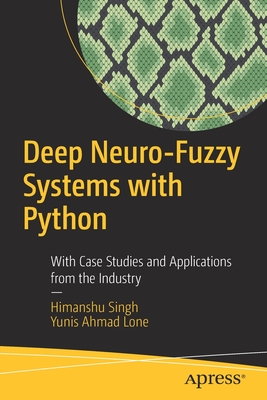Computational Intelligence Paradigms: Theory & Applications using MATLAB
暫譯: 計算智慧範式:使用 MATLAB 的理論與應用
S. Sumathi, Surekha Paneerselvam
- 出版商: CRC
- 出版日期: 2009-12-01
- 售價: $4,725
- 貴賓價: 9.5 折 $4,489
- 語言: 英文
- 頁數: 851
- 裝訂: Hardcover
- ISBN: 143980902X
- ISBN-13: 9781439809020
-
相關分類:
Matlab
-
其他版本:
Computational Intelligence Paradigms: Theory & Applications Using MATLAB
立即出貨 (庫存=1)
買這商品的人也買了...
-
 深入淺出設計模式 (Head First Design Patterns)
深入淺出設計模式 (Head First Design Patterns)$880$695 -
 嵌入式系統─使用 C 和 GNU 開發工具 (Programming Embedded Systems with C and GNU Development Tools, 2/e)
嵌入式系統─使用 C 和 GNU 開發工具 (Programming Embedded Systems with C and GNU Development Tools, 2/e)$680$537 -
 $1,488C++ GUI Programming with Qt 4, 2/e (Hardcover)
$1,488C++ GUI Programming with Qt 4, 2/e (Hardcover) -
 iPhone 創意開發入門與實作
iPhone 創意開發入門與實作$480$408 -
 精通 JavaScript + jQuery
精通 JavaScript + jQuery$580$458 -
 全球最強 VMware vSphere 4 企業環境建構
全球最強 VMware vSphere 4 企業環境建構$860$731 -
 VMware vSphere and Virtual Infrastructure Security: Securing the Virtual Environment (Paperback)
VMware vSphere and Virtual Infrastructure Security: Securing the Virtual Environment (Paperback)$1,815$1,724 -
 程式設計師的自我修養-連結、載入、程式庫
程式設計師的自我修養-連結、載入、程式庫$580$493 -
 Google!Android 2 手機應用程式設計入門, 3/e
Google!Android 2 手機應用程式設計入門, 3/e$530$419 -
 巧用 jQuery
巧用 jQuery$490$387 -
 Windows Server 2008 R2 網路管理與架站
Windows Server 2008 R2 網路管理與架站$650$514 -
 深入淺出 Android 系統原理及開發要點
深入淺出 Android 系統原理及開發要點$450$351 -
 玩通 VMware:108 個虛擬機實例講堂
玩通 VMware:108 個虛擬機實例講堂$480$408 -
 嵌入式系統開發之道-菜鳥成長日誌與專案經理的私房菜
嵌入式系統開發之道-菜鳥成長日誌與專案經理的私房菜$850$723 -
 PHP 6 & MySQL 6 網頁資料庫程式設計演繹
PHP 6 & MySQL 6 網頁資料庫程式設計演繹$600$474 -
24 小時不打烊的雲端服務-專家教你用 CentOS 架設萬年不掛的伺服器
$680$530 -
 Android 4.X 手機/平板電腦程式設計入門、應用到精通, 2/e (適用 Android 1.X~4.X)
Android 4.X 手機/平板電腦程式設計入門、應用到精通, 2/e (適用 Android 1.X~4.X)$520$411 -
 Linux 裝置驅動程式之開發詳解, 2/e
Linux 裝置驅動程式之開發詳解, 2/e$780$616 -
 《超強圖解》前進 Android Market!Google Android SDK 實戰演練, 2/e (適用2.X/3.X/4.X)
《超強圖解》前進 Android Market!Google Android SDK 實戰演練, 2/e (適用2.X/3.X/4.X)$750$638 -
 iOS 創意程式設計家─ iPhone + iPad 跨平台通用, 3/e
iOS 創意程式設計家─ iPhone + iPad 跨平台通用, 3/e$580$458 -
 JavaScript 大全, 6/e (JavaScript: The Definitive Guide: Activate Your Web Pages, 6/e)
JavaScript 大全, 6/e (JavaScript: The Definitive Guide: Activate Your Web Pages, 6/e)$1,200$948 -
 Android 4.X 應用程式開發之鑰
Android 4.X 應用程式開發之鑰$680$578 -
 Android 核心剖析
Android 核心剖析$650$514 -
 編程 ING-人人都能學會程式設計
編程 ING-人人都能學會程式設計$390$308 -
 PHP 大師-寫出頂尖的程式碼 (PHP Master: Write Cutting Edge Code)
PHP 大師-寫出頂尖的程式碼 (PHP Master: Write Cutting Edge Code)$450$356
商品描述
Offering a wide range of programming examples implemented in MATLAB®, Computational Intelligence Paradigms: Theory and Applications Using MATLAB® presents theoretical concepts and a general framework for computational intelligence (CI) approaches, including artificial neural networks, fuzzy systems, evolutionary computation, genetic algorithms and programming, and swarm intelligence. It covers numerous intelligent computing methodologies and algorithms used in CI research.
The book first focuses on neural networks, including common artificial neural networks; neural networks based on data classification, data association, and data conceptualization; and real-world applications of neural networks. It then discusses fuzzy sets, fuzzy rules, applications of fuzzy systems, and different types of fused neuro-fuzzy systems, before providing MATLAB illustrations of ANFIS, classification and regression trees, fuzzy c-means clustering algorithms, fuzzy ART map, and Takagi–Sugeno inference systems. The authors also describe the history, advantages, and disadvantages of evolutionary computation and include solved MATLAB programs to illustrate the implementation of evolutionary computation in various problems. After exploring the operators and parameters of genetic algorithms, they cover the steps and MATLAB routines of genetic programming. The final chapter introduces swarm intelligence and its applications, particle swarm optimization, and ant colony optimization.
Full of worked examples and end-of-chapter questions, this comprehensive book explains how to use MATLAB to implement CI techniques for the solution of biological problems. It will help readers with their work on evolution dynamics, self-organization, natural and artificial morphogenesis, emergent collective behaviors, swarm intelligence, evolutionary strategies, genetic programming, and the evolution of social behaviors.
商品描述(中文翻譯)
提供一系列使用 MATLAB® 實作的程式範例,計算智慧範式:使用 MATLAB® 的理論與應用 介紹了計算智慧 (CI) 方法的理論概念和一般框架,包括人工神經網路、模糊系統、演化計算、遺傳演算法及程式設計,以及群體智慧。書中涵蓋了許多在 CI 研究中使用的智能計算方法論和演算法。
本書首先聚焦於神經網路,包括常見的人工神經網路;基於數據分類、數據關聯和數據概念化的神經網路;以及神經網路的實際應用。接著討論模糊集合、模糊規則、模糊系統的應用,以及不同類型的融合神經模糊系統,然後提供 MATLAB 的 ANFIS、分類與回歸樹、模糊 c-均值聚類演算法、模糊 ART 地圖和 Takagi–Sugeno 推理系統的示例。作者還描述了演化計算的歷史、優點和缺點,並包含解決的 MATLAB 程式以說明演化計算在各種問題中的實作。在探討遺傳演算法的運算子和參數後,書中涵蓋了遺傳程式設計的步驟和 MATLAB 程式。最後一章介紹了群體智慧及其應用、粒子群優化和蟻群優化。
這本內容豐富的書籍充滿了實作範例和章末問題,解釋了如何使用 MATLAB 實作 CI 技術以解決生物問題。它將幫助讀者在演化動力學、自組織、自然與人工形態生成、突現集體行為、群體智慧、演化策略、遺傳程式設計以及社會行為的演化方面的工作。

















